How to assemble, paint and age a ceramic kit.
Part One.
Well, hydrocal plaster anyway! : ) The following techniques will work with most plaster building kits, whether they are from Verlinden, Tiger or Dioramas Plus. I'll break the steps down into seperate posts so they don't all run together.
First, a word about plaster kits. Because of the casting process, most have detail on every surface except the back of the casting, which is usually the interior. Since the interior walls are usually fairly flat anyway, this is easy to overcome because you can add wallpaper, wood paneling, trim or whatever if you decide you need to detail the interior of the building.
Most plaster kits are usually comprised of just a few simple parts that need to be glued together, as most of the detail is cast right in place. That means you can get past the assembly part pretty quickly & get right to the fun part, painting & detailing your building.
The sample I'll be illustrating here is one of my kits, DP2, The Goverment Ruins. As I said though, these basic instructions should work for most plaster kits & even scratch built projects you may do in the future.
Gluing the parts together. This kit has just three main parts. Before gluing them together take a minute or two to clean up the edges and make sure that you understand how they fit together.
I prefer 5 minute epoxy for assembling plaster parts. You can use white or carpenters glue, however, if you get your building really wet during the painting/aging stage the glue can soften and fail. You could also use super glue, but since the plaster is so porous you'd need to use a lot of it, not to mention that for me, the super glue always seems to "go off:" just the second I wiggle the parts I was holding together. : )
In any case, I prefer the 5 minute epoxy. It gives you enough time to make sure that the parts are straight and true, but you don't have to wait all day for it to set. Mix up a small amount of the epoxy and glue the parts together. Be careful to not use too much glue, or it could sqwish out & mar the surface of you model. If some oozes out wipe it off asap.
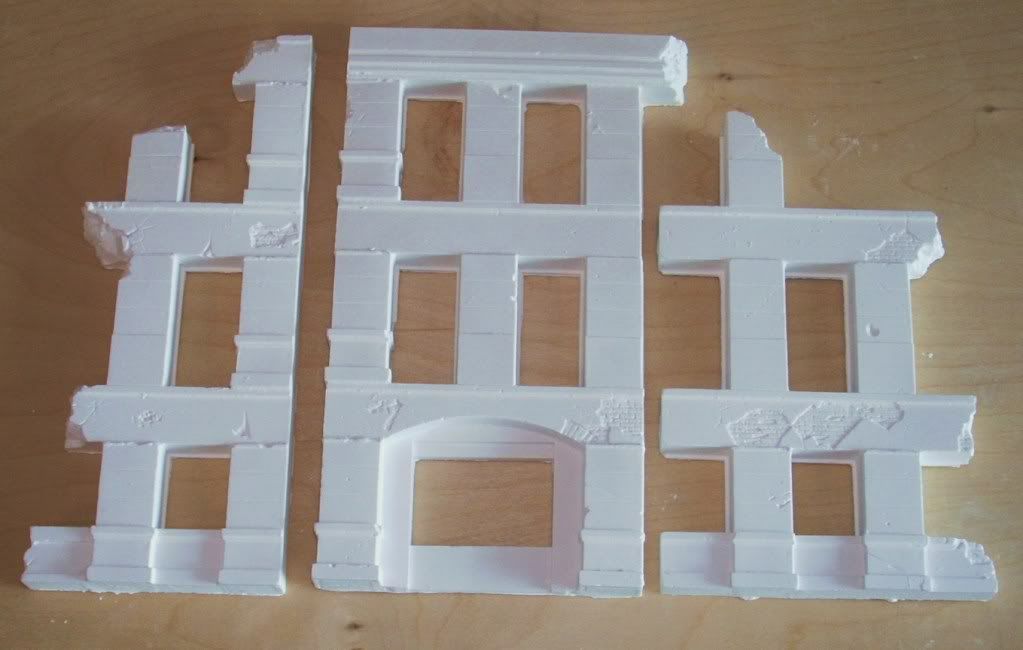
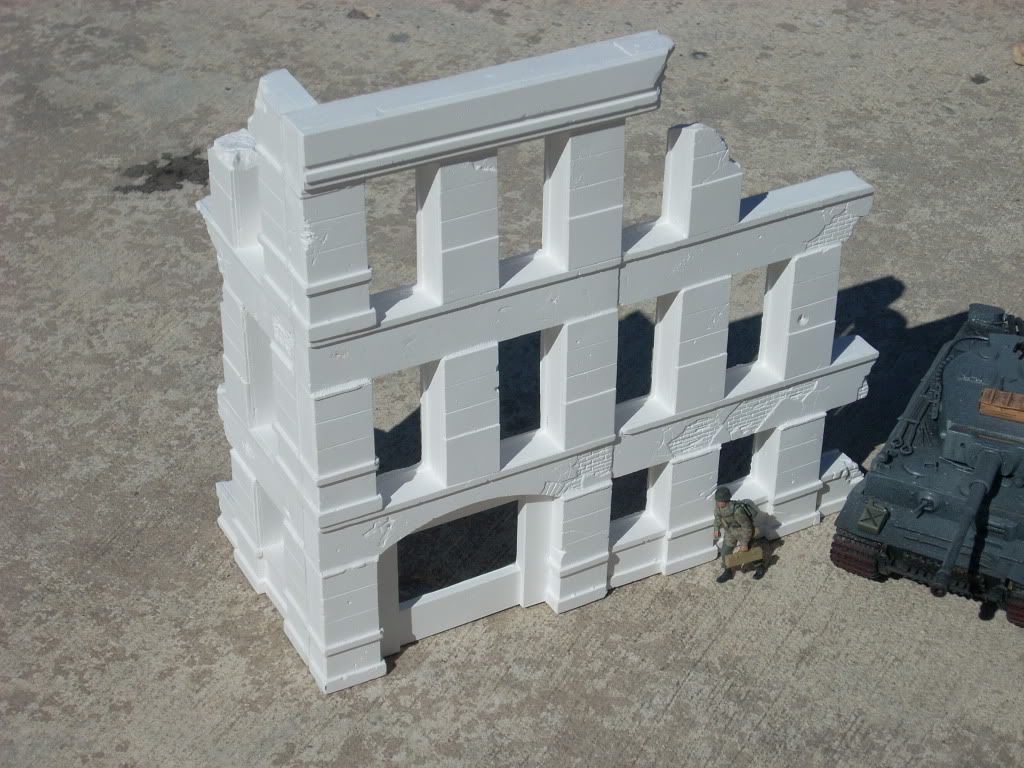
While in most cases plaster buildings fit together pretty well if you feel that are any seams or joints you need to hide you can use standard lightweight household spackle.
From unwrapping the castings to getting glued together for the first coat of primer was about 15 minutes, This is, IMO, one of the real advantages of this type of kit. Also, the plaster parts can be easily cut or modified if needed for a special project.
On to the painting!
Part Two.
I always prime my plaster castings before I add any color. I prime them to take some of the porosity out of the plaster so that when I add my colors they do not soak in instantly. In other words, you're not looking to give the castings so many coats of primer that the parts are hard, shiney and completely waterproof (like plastic), but rather, that they just don't soak in the colors as quickly. That way you'll have a little "work time" with your colors and will be able to move them around a bit & even "wash" them off a bit if they are too dark.
What I use to prime the parts is simply 3 or 4 light coats of flat white Krylon spray paint. Let dry in between each coat. I use flat paint but gloss or satin can be used as well. If you do use gloss or satin you will get a little different end result when you add the colors later, as the surface will be more slippery and the color coat will not adhere to it as well. That's neither good nor bad, just different depending on what kind of effect you are trying to acheive.
Let primer dry completely (preferably over night) before moving on to the color coat.
Part Three.
OK, let's add some color to the building. I suggest painting the building before adding the doors and windows.
I almost always use the cheap water based acrylic "craft" paints you can find at Micheal's or Wal Mart. For the bricks on the building I used Plaid Apple Barrel # 20845 Terra Cotta. I thinned the paint down about 50% and painted in the bricks.
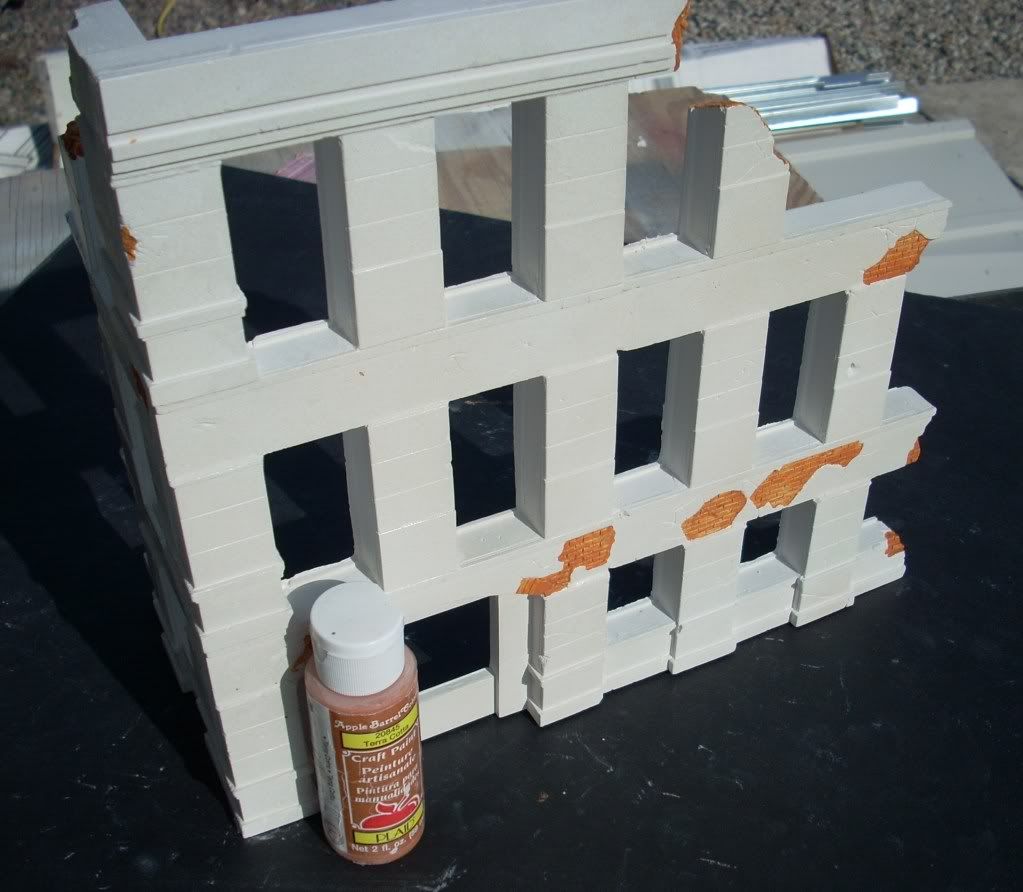
Next what I did was to paint a few of the bricks darker and a few of them lighter. Simply take the basic Terra Cotta color and mix up two small batches. Add a little white to one batch and a little black or dark brown to the other. Now, using a small brush (and a steady hand), paint a few of the bricks as shown here. You don't need to spend too much time on this step. In my opinion you should be able to paint all the bricks you need to in 5 or 10 minutes.
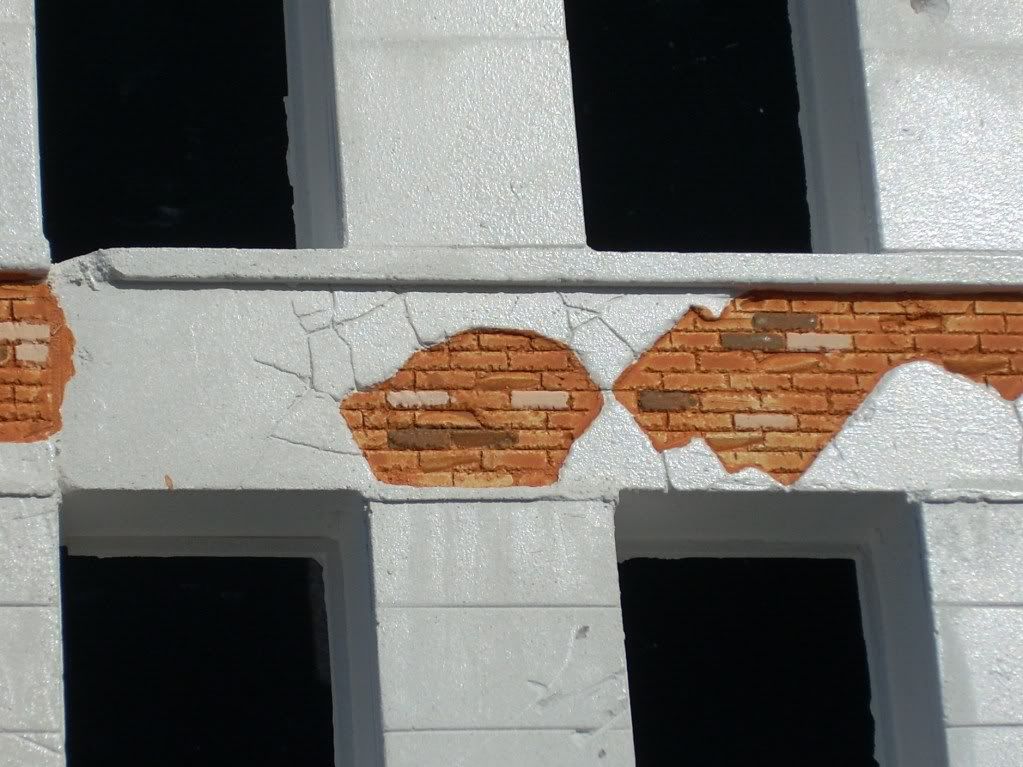
I next added a "wash" to the entire structure using thinned down Plaid Apple Barrel "Black" paint. I thinned the paint down approximately 75% using water and applied with a 1" brush. I did this step sloppy and quick, making sure to use enough water to make the dirt wash "flow" naturally over the structure. Make sure that you get the cracks, crevices and inside the door/window openings.

At this point the paint may look a little funky/blotchy. While you can't go too wrong (after all, this is a battle damaged building) there is a simple way to make it look much more realistic and natural. When the paint dried what I did was to ever so lightly "buff" the surface of the building using fine steel wool. This sort of has an effect like dry brushing, only, rather than adding paint you are taking a tiny bit off of the model. The black wash gets gently removed from the high points of the model yet it stays in the recessed detail making it look even more pronounced.
It is easy to overdo this step so just do a little bit at a time.
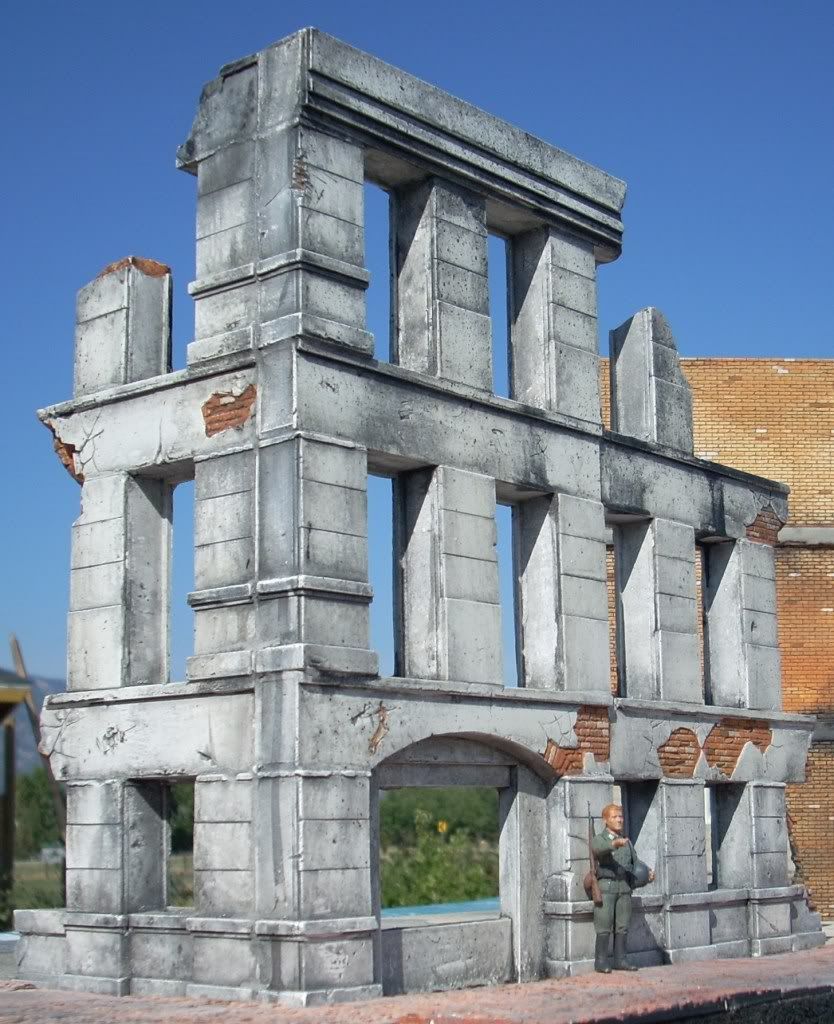
Next we add the doors/window/glass.
Part Four.
Next I added the doors, windows and glass. The doors & windows in this kit are laser cut wood parts. The parts should be painted before you install them in the building. Because wood can warp if you get it too wet, what I usually do is to give the parts 2 or 3 very light coats of spray paint rather than trying to brush paint them. For aging, you can then mist over a little light tan (for dust) or flat black (soot). You can also dry brush the parts a bit to add even more weathering.
The doors and windows in this kit are backed with self adhesive material. Simply peel the backing off, and stick the glass in place. This kit includes both broken and unbroken glass so you can use what you think looks best for your scene.
Glue the wood parts to the structure using either white glue or gap filling super glue.
I misted the glass (& the entire structure, for that matter) with dull coat. It creates a dirty haze over the broken glass that really makes it stand out. You can't have the windows in a war torn building look as though the maid had just cleaned them! : ).
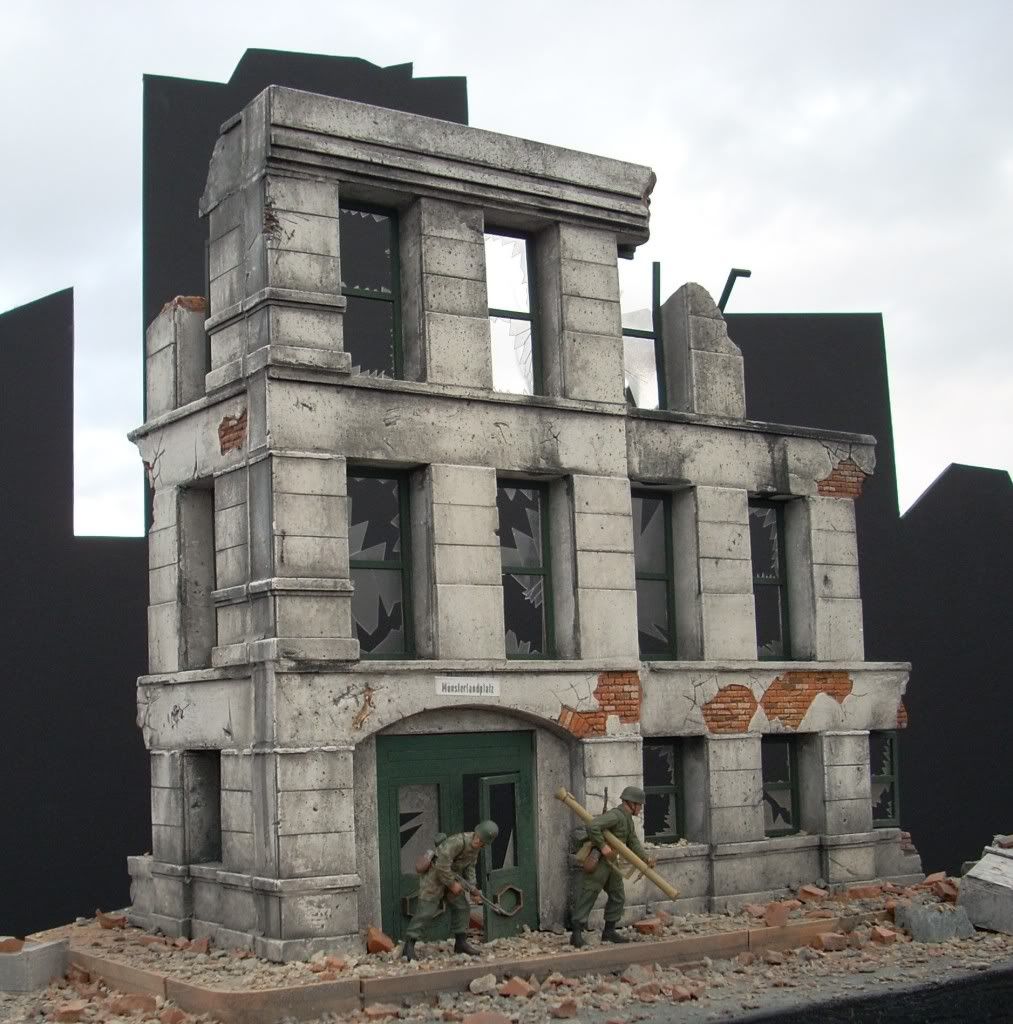
There you go, the basics on assembling and painting a ceramic/plaster kit. If you have any questions please feel free to ask.
Randy Pepprock
Dioramas Plus
www.dioramasplus.com